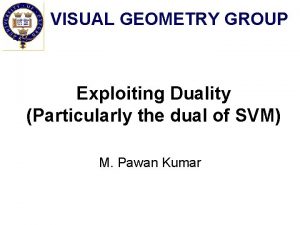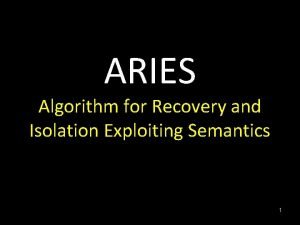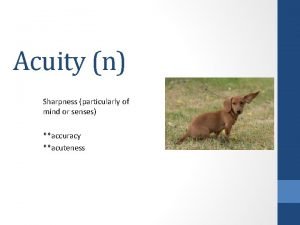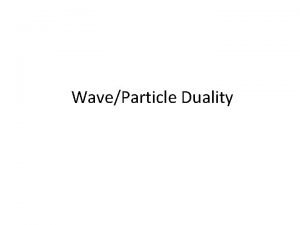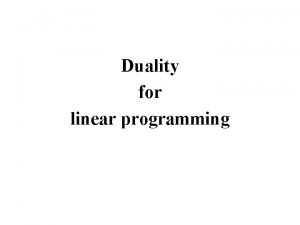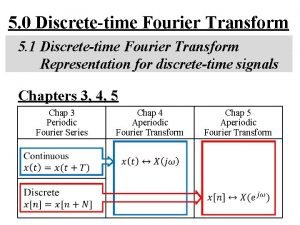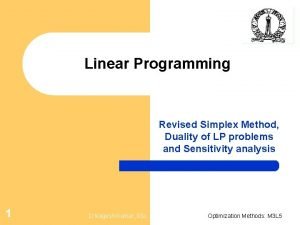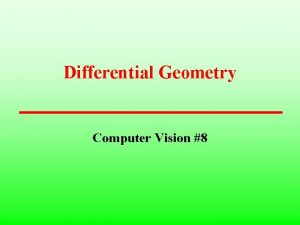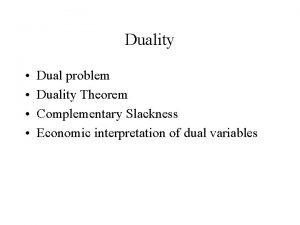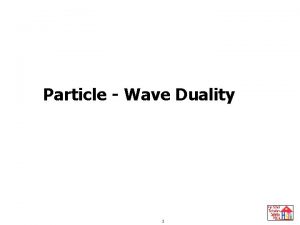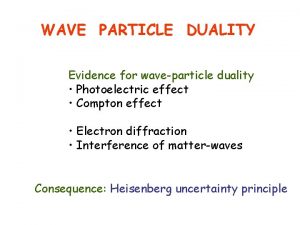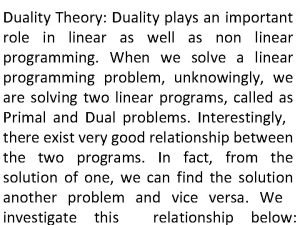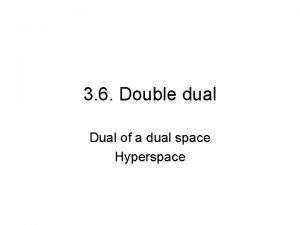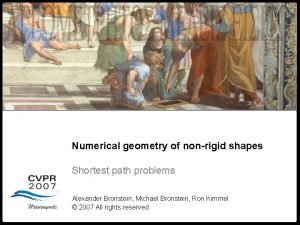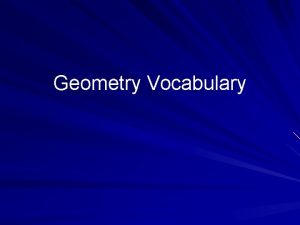VISUAL GEOMETRY GROUP Exploiting Duality Particularly the dual




























































- Slides: 60

VISUAL GEOMETRY GROUP Exploiting Duality (Particularly the dual of SVM) M. Pawan Kumar

PART I : General duality theory • Basics of Mathematical Optimization • The algebra • The geometry • Examples PART II : Solving the SVM dual • General Decomposition Algorithm • Good Working Set • Implementation Details

Mathematical Optimization min f 0(x) s. t. fi(x) ≤ 0 hi(x) = 0 Objective function Inequality constraints Equality constraints x is a feasible point fi(x) ≤ 0, hi(x) = 0 x is a strictly feasible point fi(x) < 0, hi(x) = 0 Feasible region - set of all feasible points

Convex Optimization min f 0(x) s. t. fi(x) ≤ 0 hi(x) = 0 Objective function Inequality constraints Equality constraints Feasible region is convex Objective function is convex Convex set? ? ? Convex function? ? ?

Convex Set Line Segment x 1 x 2 c x 1 + (1 - c) x 2 c [0, 1] Endpoints

Convex Set x 1 x 2 All points on the line segment lie within the set For all line segments with endpoints in the set

Non-Convex Set x 1 x 2

Examples of Convex Sets x 1 x 2 Line Segment

Examples of Convex Sets x 1 x 2 Line

Examples of Convex Sets Hyperplane a. Tx - b = 0

Examples of Convex Sets Halfspace a. Tx - b ≤ 0

Examples of Convex Sets t x 2 x 1 Second-order Cone ||x|| ≤ t

Operations that Preserve Convexity Intersection Polyhedron / Polytope

Operations that Preserve Convexity Intersection

Operations that Preserve Convexity Affine Transformation x Ax + b

Convex Function f(x) x 1 x 2 x Blue point always lies above red point

Convex Function f(x) x 1 x 2 x f( c x 1 + (1 - c) x 2 ) ≤ c f(x 1) + (1 - c) f(x 2) Domain of f(. ) has to be convex

Convex Function f(x) x 1 x 2 x f( c x 1 + (1 - c) x 2 ) ≤ c f(x 1) + (1 - c) f(x 2) -f(. ) is concave

Convex Function Once-differentiable functions f(y) + f(y)T (x - y) ≤ f(x) (y, f(y)) f(y) + f(y)T (x - y) x Twice-differentiable functions 2 f(x) 0

Convex Function and Convex Sets f(x) x Epigraph of a convex function is a convex set

Examples of Convex Functions Linear function a. Tx p-Norm functions (x 1 p + x 2 p + xnp)1/p, p ≥ 1 Quadratic functions x. T Q x Q 0

Operations that Preserve Convexity Non-negative weighted sum f 1(x) f 2(x) + w 2 w 1 + …. x x x. T Q x + a. T x + b Q 0

Operations that Preserve Convexity Pointwise maximum f 1(x) f 2(x) , max x x Pointwise minimum of concave functions is concave

Convex Optimization min f 0(x) s. t. fi(x) ≤ 0 hi(x) = 0 Objective function Inequality constraints Equality constraints Feasible region is convex Objective function is convex

PART I : General duality theory • Basics of Mathematical Optimization • The algebra • The geometry • Examples PART II : Solving the SVM dual • General Decomposition Algorithm • Good Working Set • Implementation Details

Lagrangian min f 0(x) s. t. fi(x) ≤ 0 hi(x) = 0 L(x, , ) f 0(x) + ∑i i fi(x) + ∑i i hi(x) i ≥ 0

Lagrangian Dual L(x, , ) f 0(x) + ∑i i fi(x) + ∑i i hi(x) i ≥ 0 g( , ) minx L(x, , )�� x belongs to intersection of domains of f 0, fi and hi x D

Lagrangian Dual g( , ) = minx f 0(x) + ∑i i fi(x) + ∑i i hi(x) i ≥ 0 Pointwise minimum of affine (concave) functions Dual function is concave

Lagrangian Dual p* = min f 0(x) s. t. fi(x) ≤ 0 hi(x) = 0 ≥ For all ( , ) g( , ) = minx f 0(x) + ∑i i fi(x) + ∑i i hi(x) i ≥ 0

The Dual Problem The lower bound could be far from p* Best lower bound? Easy to obtain d* = max , minx f 0(x) + ∑ f (x) + ∑ h (x) i i i i ≥ 0 p* - d* ≥ 0 Duality Gap

The Geometric Interpretation u v t (fi(x), hi(x), f 0(x)) G x D t G p* u

The Geometric Interpretation ( , , 1)T (u, v, t) ≥ g( , ) t G p* d* g( ) u

The Duality Gap p* = min f 0(x) s. t. fi(x) ≤ 0 ≥ hi(x) = 0 d* = max , minx f 0(x) + ∑i i fi(x) + ∑i i hi(x) i ≥ 0

The Duality Gap p* - d* ≥ 0 Weak Duality p* - d* = 0 Strong Duality

Strong Duality Problem is convex There exists a strictly feasible point Taken care of by most solvers Slater’s Condition

At Strong Duality f 0(x*) = g( *, *) = minx ( f 0(x) + ∑i i*fi(x) + ∑i i*hi(x) ) ≤ f 0(x*) + ∑i i*fi(x*) + ∑i i*hi(x*) ≤ f 0(x*) Inequalities hold with equality x* minimizes the Lagrangian at ( *, *)

At Strong Duality f 0(x*) = g( *, *) = minx ( f 0(x) + ∑i i*fi(x) + ∑i i*hi(x) ) ≤ f 0(x*) + ∑i i*fi(x*) + ∑i i*hi(x*) ≤ f 0(x*) Inequalities hold with equality i*fi(x*) = 0

KKT Conditions fi(x*) ≤ 0 hi(x*) = 0 i* ≥ 0 i*fi(x*) = 0 Primal feasible Dual feasible Complementary Slackness f 0(x*) + ∑i i* fi(x*) + ∑i i* hi(x*) = 0 Necessary conditions for strong duality

KKT Conditions fi(x*) ≤ 0 hi(x*) = 0 i* ≥ 0 i*fi(x*) = 0 Primal feasible Dual feasible Complementary Slackness f 0(x*) + ∑i i* fi(x*) + ∑i i* hi(x*) = 0 Necessary and sufficient for convex problems

PART I : General duality theory • Basics of Mathematical Optimization • The algebra • The geometry • Examples PART II : Solving the SVM dual • General Decomposition Algorithm • Good Working Set • Implementation Details

Linear Program min c. Tx s. t. A x = b x ≥ 0

QCQP min (1/2)x. TP 0 x + q 0 x + r 0 s. t. (1/2)x. TPix + qix + ri

Entropy Maximization min ∑i xi log(xi) s. t. A x ≤ b ∑i xi = 1

The SVM Framework w Tx + b = 0 2/||w|| min 1/2 w. Tw + C i yi (w. Txi + b) ≥ 1 - i i ≥ 0 Points X = {xi} Labels y= {yi} yi {-1, +1} Convex Quadratic Program

The SVM Dual min (1/2) TQ - T 1 s. t. Ty = 0 0 ≤ ≤ C 1 Qij = yiyjxi. Txj = yiyj k(xi, xj)

PART I : General duality theory • Basics of Mathematical Optimization • The algebra • The geometry • Examples PART II : Solving the SVM dual • General Decomposition Algorithm • Good Working Set • Implementation Details

The SVM Dual min (1/2) TQ - T 1 s. t. Ty = 0 0 ≤ ≤ C 1 Choose ‘q’ variables. Fix the rest. Best set B? Change unfixed variables, satisfying constraints, to decrease objective function (small problem). Repeat. Minimum ‘q’ ? ? ? Till When ? ? ?

KKT Conditions min (1/2) TQ - T 1 s. t. ilo Ty =0 0 ≤ ≤ C 1 eq iup g( ) -1 + Q + eqy - lo + up = 0 ilo i = 0 iup ( i - C) = 0 ilo ≥ 0 iup ≥ 0

KKT Conditions -1 + g( ) + eqy - lo + up = 0 ilo i = 0 ilo ≥ 0 For all 0 < i < C iup ( i - C) = 0 iup ≥ 0 -1 + gi( ) + eqyi = 0 For all i = 0 -1 + gi( ) + eqyi - ilo = 0 For all i = C -1 + gi( ) + eqyi + iup = 0

KKT Conditions -1 + g( ) + eqy - lo + up = 0 ilo i = 0 ilo ≥ 0 iup ( i - C) = 0 iup ≥ 0 gi( ) = yi ∑j jyj k(xi, xj) git( ) = gi( t-1) + yi ∑j B ( jt - jt-1)yj k(xi, xj) Best set of ‘q’ variables (Working set)

PART I : General duality theory • Basics of Mathematical Optimization • The algebra • The geometry • Examples PART II : Solving the SVM dual • General Decomposition Algorithm • Good Working Set • Implementation Details

Working Set gi( ) = yi ∑j jyj k(xi, xj) d : feasible direction of descent t = t-1 + d Choose steepest descent direction First order approximation of objective (-1 + g( t-1))T d

Working Set mind (-1 + g( t-1))T d s. t. y. T d = 0 di ≥ 0 if it-1 = 0 di ≤ 0 if it-1 = C Card{d} = q -1 ≤ di ≤ 1

Working Set si = yi (-1 + gi( t-1)) Sort according decreasing values of si Choose q/2 from top if 0 < it-1 < C, or di = -yi satisfies feasibility of direction Choose q/2 from bottom if 0 < it-1 < C, or di = yi satisfies feasibility of direction

Working Set mind (-1 + g( t-1))T d s. t. y. T d = 0 di ≥ 0 if it-1 = 0 di ≤ 0 if it-1 = C Card{d} = q -1 ≤ di ≤ 1

PART I : General duality theory • Basics of Mathematical Optimization • The algebra • The geometry • Examples PART II : Solving the SVM dual • General Decomposition Algorithm • Good Working Set • Implementation Details

Shrinking For all 0 < i < C -1 + gi( ) + eqyi = 0 For all i = 0 -1 + gi( ) + eqyi - ilo = 0 For all i = C -1 + gi( ) + eqyi + iup = 0 If ilo > 0 or iup > 0 for n consecutive iterations Drop i from problem (temporarily)

Caching Kernel evaluation can be expensive Cache them in a least-recently-used manner Choose q’ variables where cache available

Results Those who have used SVMlight : You know that it works very well. Those who haven’t used SVMlight : It works very well. See paper. Download.

Questions? ? ?
 Visual geometry group
Visual geometry group X factor
X factor Virtual value
Virtual value Generation of new entry opportunity
Generation of new entry opportunity Pure-ftpd exploit
Pure-ftpd exploit Large and fast: exploiting memory hierarchy
Large and fast: exploiting memory hierarchy Aries algorithm
Aries algorithm Exploiting machine learning to subvert your spam filter
Exploiting machine learning to subvert your spam filter Sem promotion
Sem promotion I don't particularly like modes a lot
I don't particularly like modes a lot Sharpness of mind
Sharpness of mind Pea plants were particularly well suited
Pea plants were particularly well suited The senate of republican rome particularly represented
The senate of republican rome particularly represented Young children are particularly sensitive to ets
Young children are particularly sensitive to ets Pea plants were particularly well suited
Pea plants were particularly well suited Vsepr model vs lewis structure
Vsepr model vs lewis structure Electron domain geometry vs molecular geometry
Electron domain geometry vs molecular geometry The basis of the vsepr model of molecular bonding is _____.
The basis of the vsepr model of molecular bonding is _____. Langua
Langua Wave particle duality questions
Wave particle duality questions Ultimate reality meaning
Ultimate reality meaning Holographic duality theory
Holographic duality theory Duality memory
Duality memory Ctft properties
Ctft properties Teori dualitas adalah
Teori dualitas adalah Rect(t-1/2)
Rect(t-1/2) Importance of language
Importance of language Niels bohr analogy
Niels bohr analogy Properties of language duality
Properties of language duality Linguistic arbitrariness
Linguistic arbitrariness Radiation integrals and auxiliary potential functions
Radiation integrals and auxiliary potential functions Homosexuality in jekyll and hyde quotes
Homosexuality in jekyll and hyde quotes Dual problem in lpp
Dual problem in lpp Duality in discrete mathematics
Duality in discrete mathematics Fourier transform of sinc
Fourier transform of sinc Fourier series formula
Fourier series formula Sensitivity analysis and duality
Sensitivity analysis and duality Features of human language
Features of human language Duality of fourier transform
Duality of fourier transform What is duality in accounting
What is duality in accounting Duality law
Duality law Duality of confidence interval and hypothesis test
Duality of confidence interval and hypothesis test Customer supplier duality
Customer supplier duality Pathetic fallacy in jekyll and hyde
Pathetic fallacy in jekyll and hyde Simplex method
Simplex method Duality in frankenstein
Duality in frankenstein Anand rangarajan
Anand rangarajan Primeradiant
Primeradiant Wave-particle duality
Wave-particle duality Self-duality
Self-duality Isss kent
Isss kent Boundary equilibrium gan
Boundary equilibrium gan Normal curvature
Normal curvature Apa yang dimaksud dengan pemrograman konvensional
Apa yang dimaksud dengan pemrograman konvensional Hình ảnh bộ gõ cơ thể búng tay
Hình ảnh bộ gõ cơ thể búng tay Lp html
Lp html Bổ thể
Bổ thể Tỉ lệ cơ thể trẻ em
Tỉ lệ cơ thể trẻ em Voi kéo gỗ như thế nào
Voi kéo gỗ như thế nào Tư thế worm breton là gì
Tư thế worm breton là gì Chúa sống lại
Chúa sống lại
